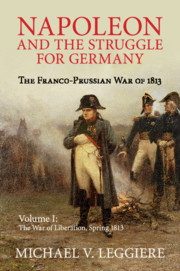Refine search
Actions for selected content:
15418 results in Military history
Introduction
-
- Book:
- Napoleon and the Struggle for Germany
- Published online:
- 05 April 2015
- Print publication:
- 09 April 2015, pp 1-20
-
- Chapter
- Export citation
Preface
-
- Book:
- Napoleon and the Struggle for Germany
- Published online:
- 05 April 2015
- Print publication:
- 09 April 2015, pp xi-xii
-
- Chapter
- Export citation
Index
-
- Book:
- Napoleon and the Struggle for Germany
- Published online:
- 05 April 2015
- Print publication:
- 09 April 2015, pp 465-488
-
- Chapter
- Export citation
2 - A new Coalition
-
- Book:
- Napoleon and the Struggle for Germany
- Published online:
- 05 April 2015
- Print publication:
- 09 April 2015, pp 70-119
-
- Chapter
- Export citation
4 - The Saale
-
- Book:
- Napoleon and the Struggle for Germany
- Published online:
- 05 April 2015
- Print publication:
- 09 April 2015, pp 175-225
-
- Chapter
- Export citation
1 - Odd man out
-
- Book:
- Napoleon and the Struggle for Germany
- Published online:
- 05 April 2015
- Print publication:
- 09 April 2015, pp 21-69
-
- Chapter
- Export citation
Frontmatter
-
- Book:
- Napoleon and the Struggle for Germany
- Published online:
- 05 April 2015
- Print publication:
- 09 April 2015, pp i-iv
-
- Chapter
- Export citation
List of Maps
-
- Book:
- Napoleon and the Struggle for Germany
- Published online:
- 05 April 2015
- Print publication:
- 09 April 2015, pp ix-x
-
- Chapter
- Export citation
8 - The Prussian Thermopylae
-
- Book:
- Napoleon and the Struggle for Germany
- Published online:
- 05 April 2015
- Print publication:
- 09 April 2015, pp 336-381
-
- Chapter
- Export citation
List of Figures
-
- Book:
- Napoleon and the Struggle for Germany
- Published online:
- 05 April 2015
- Print publication:
- 09 April 2015, pp viii-viii
-
- Chapter
- Export citation
3 - Saxony
-
- Book:
- Napoleon and the Struggle for Germany
- Published online:
- 05 April 2015
- Print publication:
- 09 April 2015, pp 120-174
-
- Chapter
- Export citation
Assessment
-
- Book:
- Napoleon and the Struggle for Germany
- Published online:
- 05 April 2015
- Print publication:
- 09 April 2015, pp 429-455
-
- Chapter
- Export citation
Contents
-
- Book:
- Napoleon and the Struggle for Germany
- Published online:
- 05 April 2015
- Print publication:
- 09 April 2015, pp vii-vii
-
- Chapter
- Export citation
6 - The Elbe
-
- Book:
- Napoleon and the Struggle for Germany
- Published online:
- 05 April 2015
- Print publication:
- 09 April 2015, pp 268-297
-
- Chapter
- Export citation

Napoleon and the Struggle for Germany
- The Franco-Prussian War of 1813
-
- Published online:
- 05 April 2015
- Print publication:
- 09 April 2015
Conclusion
-
- Book:
- Revisiting Prussia's Wars against Napoleon
- Published online:
- 05 March 2015
- Print publication:
- 30 March 2015, pp 335-336
-
- Chapter
- Export citation
Conclusion
-
- Book:
- Revisiting Prussia's Wars against Napoleon
- Published online:
- 05 March 2015
- Print publication:
- 30 March 2015, pp 247-248
-
- Chapter
- Export citation
8 - Military Service
-
- Book:
- Revisiting Prussia's Wars against Napoleon
- Published online:
- 05 March 2015
- Print publication:
- 30 March 2015, pp 177-193
-
- Chapter
- Export citation
6 - Debating War
-
- Book:
- Revisiting Prussia's Wars against Napoleon
- Published online:
- 05 March 2015
- Print publication:
- 30 March 2015, pp 130-154
-
- Chapter
- Export citation
13 - Inventing History
-
- Book:
- Revisiting Prussia's Wars against Napoleon
- Published online:
- 05 March 2015
- Print publication:
- 30 March 2015, pp 273-300
-
- Chapter
- Export citation
